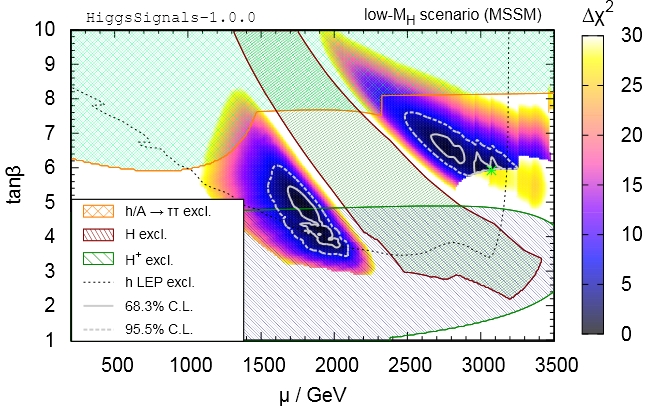With the null results of dozens of dedicated searches the ATLAS and CMS experiments have by now eaten out roughly half of the "reasonable" portion of the unbounded, hundred-something-dimensional parameter space of SUSY theories. And maybe what is most depressing for SUSY aficionados is that in particular the most natural values for the masses of the hypothetical super-particles predicted by the theory are now ruled out, such that one of the most enthusiastically publicized features of the new physics model, its "naturalness-restoring" power, is already significantly diminished. [For a simple explanation of what naturalness is and the role of Supersymmetry in restoring it see here.]
As most of you well know, I have been quite sceptical of the correctness of Supersymmetry since non-suspicious times when everybody would look at me like a white fly for my attitude. Nowadays my life is easier, but I need to insist in letting one thing be known when I discuss the failure of appearance of supersymmetric particles at the LHC: I would be just as delighted if we did discover them than any of my colleagues.
The $1000 bet that I placed seven years ago (against theoretician Jacques Distler for $750, and ATLAS experimentalist Gordon Watts for the remaining $250) was in that sense an "insurance bet" for me: some extra cash to enjoy to make up for the disappointment of being part of a only partly successful experiment. Yes, we found the Higgs boson!... But we are only half happy about the situation we are in now.
[By the way, the payoff time for that bet is coming: in less than a month it will be one year since the delivery to the ATLAS and CMS experiments of 10 inverse femtobarns of collisions each, and by that time if neither collaboration claims a 5-sigma discovery of new physics I am officially winning the bets.]
Anyway, today's post is about the μ parameter of SUSY. This is called "Higgsino mass parameter", and it is one of the less publicized of the five free parameters which are chosen as the "core set" defining the main features of Supersymmetric realizations. Other parameters are better known: in particular tanβ, a pure number equal to the ratio of the vacuum expectation values of the two higgs doublets present in minimal supersymmetric extensions of the standard model, and mA, the mass of the CP-odd neutral Higgs boson. When the higgs sector of the MSSM is being probed, you mostly see experimental exclusion regions in the plane of these two parameters. Others are typically kept fixed when plotting the experimental limits.
So what is μ ? It is a dimensionful parameter which arises in the MSSM lagrangian density, where it multiplies the product of H_u and H_d, the chiral superfields of the Higgs doublets. Too complicated ? Okay, strike that; let's just say that it is a parameter which corresponds to the supersymmetric version of the Higgs boson mass in the standard model.
From naturalness arguments not different to the one that made SUSY fashionable, it is expected that μ should not be too different from the natural scale of electroweak symmetry breaking, i.e. 10^2 GeV; however, there is a puzzle there, since there is no a priori reason for its value to be such, when it could be anything up to the Planck mass scale. The fact that it is of the same order of the SUSY-mass-breaking terms (those terms that provide Supersymmetric particle masses way above the mass of the Standard Model ones, hiding them from the view of past experimental studies) is a source of theoretical debate and hypotheses.
Maybe I am boring most of you with these discussions. So let us jump to a graph. This is taken from a recent paper by my friend Sven Heinemeyer and collaborators. It is a very nice and complete paper which describes a quite elaborate computer program, named "HiggsSignals". HiggsSignals allows one to exploit the experimental results on Higgs boson measurements to make inferences on the Higgs sector of the MSSM, as well as other models including arbitrary Higgs boson sectors.
Rather than describing the niceties of the new program, the focus of this article is on the figure I paste below, taken from Heinemeyer et al.'s article: it shows the points in the μ-tanβ plane which are in best agreements with LHC measurements of the observed Higgs boson state, when one assumes that the one found is the higher-mass CP-even neutral scalar, implying that there exists another CP-even Higgs boson with mass below the LEP bound of 115 GeV. This is possible in a scenario where this boson decouples from the gauge bosons of the Standard Model. The scenario is called "low-MH". As you see from the figure, the information acquired with the LHC measurement have some bearing on the μ parameter, but it still remains largely unconstrained. Two different "best-fit" solutions are visible in the graph, corresponding to μ values of 1.8 or 3 TeV. Already not exactly "natural" values, in the terminology discussed above.

Worth noting is that the best-fit point in the graph above has a total chisquared of 47 with 48 degrees of freedom - looks like killing Supersymmetry will take more than a couple spoonful of protons shot at one another!





Comments